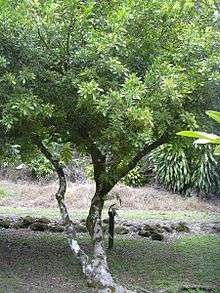Meliaceae
Meliaceae, the mahogany family, is a flowering plant family of mostly trees and shrubs (and a few herbaceous plants, mangroves) in the order Sapindales.
| Mahogany family | |
|---|---|
| Melia azedarach in flower | |
| Scientific classification | |
| Kingdom: | Plantae |
| Clade: | Tracheophytes |
| Clade: | Angiosperms |
| Clade: | Eudicots |
| Clade: | Rosids |
| Order: | Sapindales |
| Family: | Meliaceae Juss.[1] |
| Subfamilies | |
| Wikimedia Commons has media related to Meliaceae. |
They are characterised by alternate, usually pinnate leaves without stipules, and by syncarpous,[2] apparently bisexual (but actually mostly cryptically unisexual) flowers borne in panicles, cymes, spikes, or clusters. Most species are evergreen, but some are deciduous, either in the dry season or in winter.
The family includes about 53 genera and about 600 known species,[3] with a pantropical distribution; one genus (Toona) extends north into temperate China and south into southeast Australia, another (Synoum) into southeast Australia, and another (Melia) nearly as far north.
Uses
Various species are used for vegetable oil, soap-making, insecticides, and highly prized wood (mahogany).
Some economically important genera and species belong to this family:
- Neem tree Azadirachta indica (India)
- Carapa: includes the "crabwood trees" e.g. Carapa procera (South America and Africa)
- Cedrela odorata Central and South America; timber also known as Spanish-cedar
- Entandrophragma: includes sapele and "utile" or "sipo" (E. utile) of tropical Africa
- Guarea, the genus of Bossé or "pink mahogany" includes: G. thompsonii and G. cedrata (Africa)
- Khaya includes: Ivory Coast Mahogany and Senegal Mahogany (tropical Africa)
- Chinaberry or white cedar, Melia azedarach (Indomalaya and Australasia)
- Santol (Sandoricum koetjape), grown for their edible fruit in Southeast Asia and South Asia
- Lanzones (Lansium parasiticum), grown for their edible fruit in Southeast Asia
- Swietenia is the classic "mahogany" genus from the tropical Americas
- Toona: the genus of "toon tree" species (tropical Asia, Malesia, and Australia), especially Toona ciliata
Genera

Subfamily Cedreloideae
This is also known as subfamily Swietenioideae.[4][5]
other tribes and genera:
- Capuronianthus
- Carapa
- Chukrasia
- Entandrophragma
- Khaya
- Lovoa
- Neobeguea
- Pseudocedrela
- Schmardaea
- Soymida
- Swietenia
- Xylocarpus
Subfamily Melioideae
- related genera:
- Chisocheton
- Dysoxylum (synonym Pseudocarapa)
- Sphaerosacme
tribe: Guareeae[6] - Africa
- related genera:
- Heckeldora
- Leplaea
- Ruagea
- Turraeanthus
tribe: Melieae
tribe: Sandoriceae
tribe: Turraeeae
- related genera:
tribe: Trichilieae
- Astrotrichilia
- Cipadessa
- Ekebergia
- Heynea
- Lepidotrichilia
- Malleastrum
- Owenia
- Pseudobersama
- Pseudoclausena
- Pterorhachis
- Trichilia
- Walsura
tribe: Vavaeeae
tribe unassigned:
Notes
- Angiosperm Phylogeny Group (2009). "An update of the Angiosperm Phylogeny Group classification for the orders and families of flowering plants: APG III". Botanical Journal of the Linnean Society. 161 (2): 105–121. doi:10.1111/j.1095-8339.2009.00996.x.
- Of a gynoecium, made up of united carpels
- Christenhusz, M. J. M.; Byng, J. W. (2016). "The number of known plants species in the world and its annual increase". Phytotaxa. 261 (3): 201–217. doi:10.11646/phytotaxa.261.3.1.
- Gouvea CF, Dornelas MC, Rodriguez AP (2008). "Floral Development in the Tribe Cedreleae (Meliaceae, Sub-family Swietenioideae): Cedrela and Toona". Annals of Botany. 101 (1): 39–48. doi:10.1093/aob/mcm279. PMC 2701842. PMID 17981877.
|access-date=requires|url=(help) - Missouri Botanic Garden: list of Meliaceae genera (retrieved 18 January 2018)
- Koenen E (2011) Phylogenetic and biogeographic studies in Guareeae (Meliaceae: Melioideae) - (retrieved 18 January 2018)
- Koenen E (2011) ibid.
References
- Pennington, T.D. & Styles, B.T. (1975): A generic monograph of the Meliaceae. Blumea 22: 419–540.